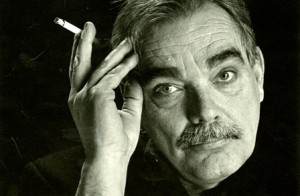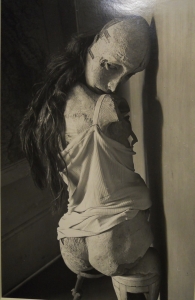There’s an interview in the new issue of APR between Gregory Donovan, Linda Gregerson, Terrance Hayes and Tony Hoagland on the subject matter of Larry Levis. The occasion of the interview is the release of Levis’s posthumous book The Darkenign Trapeze, but – as discussions about Levis inevitably does – much of the discussion focuses on his first book, Wrecking Crew, and why it is bad while the later books are good.
I have noticed that this dynamic happens every time Levis’s work is discussed. I wrote a post about it a while back on Montevidayo. Going back over that post, I find it pretty much covers my reaction to the APR interview. The Wrecking Crew is seen as “sensationalistic,” lacking in interiority, immature, spastic. What the critics don’t tend to mention is that it is profoundly influenced by foreign poetry – Latin American poetry, Garcia Lorca, the Phil Levine poems that were influenced by Surrealism and Garcia Lorca etc – but I think that sense is implicit in their criticism: the foreign is sensationalistic; functioning outside the established American tradition, the foreign becomes imitation rather than influence.
In the round-table, Hoagland and Gregerson establish some very recognizeable reasons for dismissing Wrecking Crew. Hoagland says that Levis “mainly showed a talent for the isolated, striking, somewhat surrealist image” but then matured into understanding “the sentence” as a unit of composition, and becoming more “discursive.” He repeatedly refers to the immaturity/”primitive” sensibility of Wrecking Crew (even comparing it to the “reptile brain” – ie it’s not even evolved into human-ness). Early Levis is “slight” while later Levis is “strong”; early Levis “didn’t even have… the comprehension of poetic Surrealism.” Ie he was so young he didn’t know what he was doing. Gregerson largely echoes Hoagland: Early Levis were “stop and start” (jerky, spasmatic); they depend on the image, not the sentence (the sentence is mature, the image is primitive); in the early poetry “every image is jimied into the poem by main force” while the later poems are more capacious and “relaxed”, more “organically” developed; the early poems are “a young man’s poems, a sort of sound and light show”, while the later poems is “quieter.” Overall, both Hoagland and Gregerson equate a mature, masterful style with the use of “sentence” in a way that calms and quiets the violence of the image, while immaturity is writing a poetics of violent imagery. In a Freudian model of things, we might say that early Levis engages with violence (“ballistics” instead of aesthetics as Benjamin wrote about the Dadaists), while later Levis tries to cover over, make sense, soften the blows of reality.
I think in these binaries you have a kind of manifesto of what establishment US poetry has been valuing (and abjecting) over the past 30-40 years.
(Though at the same time, making this argument more complex, Hoagland values the later Levis precisely for his profane embrace of “realism,” his baroque style. It’s almost like Hoagland praises the later Levis for qualities more applicable to Wrecking Crew.)
To bring in specifics, this is is the kind of poetry that has to be abjected from Levis’s authorship in order to recognize him as a master:
Airplanes
I get a gun and go
shoot an airplane full of holes,
and stare at the thing on the runway
until its covered with rust.
This takes years.
I turn forty somewhere, waiting
for the jet underneath me to
clear its throat of burned
starlings.
(I happen to love the syntax of this piece: “This takes years./I turn forty somwhere…” Incredibly temporal torque.)
Hoagland and Gregerson also associate early Levis with Bly’s “deep image” poetry. This is important because Bly is one of those figures who – like Plath – are supposedly so canonical and yet are used as negative examples all the time in workshop discourse. But it’s important to note which Bly they’re talking about. They’re talking about the Bly of the 1960s, who saw poetry as a kind of violence against the ego, who saw a connection between surrealism and politics (in one famous essay he writes that you can’t write truly great poetry without politics, that political uprisings attack the ego in a way that makes great poetry possible).
Hayes seems to have a more nuanced take on the early work, trying to bring the discussion around to an idea of “lyric casualness” and “almost casual (lyric) violence.” But the older two don’t seem interested in this line of thought. I think this is key: the older poets grew out of a shift in US poetry, starting in the 1970s, when Bly’s surrealism was denounced, and out of that denouncement came what we now think of as “mainstream” poetry – quietist, plain-spoken, about experiences, about interiority. In this school of thought, extravagance and style are obstacles that get in the way of communicating (an impossible ideal John Peter Durham has defined as “contact between interiorities” – ie language – and style – itself becomes a corruption of the communication process).
I’ve been thinking quite a bit about Levis and Levine and -maybe most importantly – Bly over the past few months, reading everything they wrote and pretty much everything that was written about them. Something that fascinates me is that there seems to have been some huge shift in American poetry that are seldom discussed. The first huge shift is when Bly and his journal (the Fifties, later the Sixties) create an alternative tradition based on foreign poets (from Latin America, Spain, Germany, Scandinavia) that effectively altered US poetry completely – people like Merwin and Donald Hall went from being New Critical protoges to writing surrealist/foreign-influenced (much better) poetry. This new poetics becomes profoundly intertwined with the anti-war movement. Often the shift is seen as the New American Poets influencing the New Critical poets, but I think it’s pretty obvious that it’s a matter of foreign influence.
Maybe I’m even more interested in the second shift which happens in the 1970s, when Bly and Co excise this foreign influence from their own work. The Bly of Light Around the Body and Teeth Mother Naked At Last is deeply, deeply influenced by Garcia Lorca and a foreign surrealism and a political stance. With Sleepers Joining Hands he moves into a private sphere (and heterosexual marriage) and away from politics, away from Surrealism. The same thing happens to a ton of these poets. After 1975, the Surrealist influence is totally gone from Bly. His poems are incredibly basic and plain, and all about personal experiences. The thing that interests me about this shift is that it’s not two different “schools” fighting – as poetic debates tend to be defined – but poets of the same ilk doing a complete change (Bill Knott is a notable exception here, he remained in the immature world of images and surrealism).
In an interview, Bly himself describes this shift in his work like this:
“The war brought a new corruption of language. The practice of doing ugly things, then describing them in bland words… became national policy. Since the leaders admitted to no shadow, the opposition called them all shadow, and the exaggerations on both sides damaged the language of public debate in the United States. By the end of the war, I felt some affinity gone in me, and I wanted to return to privacy rather than to go on judging, useful as judgment is.”
Here his aesthetic shift is defined as moving into a private world – which is weird because Bly was still incredibly famous and giving huge public readings all the time. But what changes is his aesthetics: his poetry becomes plain-spoken and “private.” The two seem interchangeable: plain-spoken poetry is “private.”
This is where the whole stuff about “accessible” poetry comes out of: too much style/strange stuff makes the interiority of the poem/poet inaccessible. Here I think Brian Massumi’s distinction between “emotion” and “affect” is important: “Affect” is asubjective, anarchic, while “emotion” is when the bourgeois ego captures this force, makes it recognizeable, easy to understand. If the quietist idea of “private” poem is based on an ideal of “communication” as the “contact between interiorities” – it is perhaps better to say that it values a plain style of “emotion”, without the wild, politically charged affect of say Garcia Lorca or Phil Levine’s “Angel Butcherer.”
For me this is what “quietism” means: It advocates a “plain style” as a sign of maturity and a political defense against the onslaught of mass media; plain style as somehow managing to “communicate” interiority; a rejection of explicit politics. The foreign becomes associated with the sensationalistic, with violence, because – in part at least – it demands the movement across boundaries.
Though as Eric Bennett showed in his study of the workshop, this quietism has a profoundly imperialistic element, used as cold-war propaganda quite aggressively around the world, suggesting a huge flaw in all “accessibility” rhetoric – accessible to who?
I’ll return next week with more commentary on Bly and the 1970s. Like i said, I’ve spent a lot of time researching this era and it’s been revelatory for me to see the roots of a lot of the discussions still going on today.


One aspect of American poetic literary history missing in your exploration here, it strikes me, has to do with the equation of the sentence with maturity in contrast to a ballistic poetry of images (despite the relatively periodic syntax of the poem you give as an example of Levin’s early style). SOMEWHERE Olson remarks that Pound and Williams had been working away at “the sentence” and syntax. The paratactic/juxtapositional poetics most fully exploited in the Cantos and by what scholar-poet Laszlo Gefin termed the poetics of the ideogram (in Olson, Duncan, Snyder, et al) seems an important counterpart, too, to the reactionary return to the maturely periodic (reminiscent of Metaphysical style and hence the poetics lionized by Eliot and the New Critics) you remark. Perhaps most germane, given your concern with the foreign, is the well-known fact that ideogrammic poetics is inspired by translation, from the Chinese, and, in the hands of Snyder and and other ethnopoets, from “tribal” (many non-Occidental) poetries globally. This dimension of American poetics is arguably not unrelated to the concerns you explore here.
Hi Bryan,
Sorry to be so slow approving this comment. My new blog doesn’t send me a message when I get comments so I missed it.
In what sense do you think the Pound/Olson tradition is “missing” from my account? I don’t actually think that vein of US poetry played an important role in the shift that I’m noting here, but I could be convinced otherwise. Perhaps Pound’s fascism could be part of the fear of entering into politics/the public sphere? Let me know what you think.
Also, I don’t think the “mature” style I’m talking about here – quietism, personal narrative etc – has all that much to do with Eliot or the Metaphysical poets. If anything the immature style seems more metaphysical. I think that the mature/quietist style comes out of the program era pedagogy – an adverseness to “too much”-ness. An emphasis on: calm, restrained, maturity, solemnity. That doesn’t strike me as either Eliot or Donne. But the New Critics: definitely a big influence.
The ethnopoetics and engaging with “non-occidental” poetry is of course also another (big) topic (tho Bly and Rothenberg were friends in the 50s/60s and shared an interest in “deep image” poetry).
Thanks,
Johannes